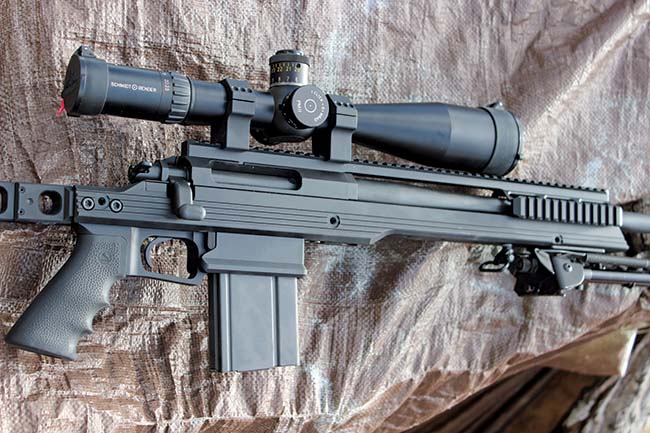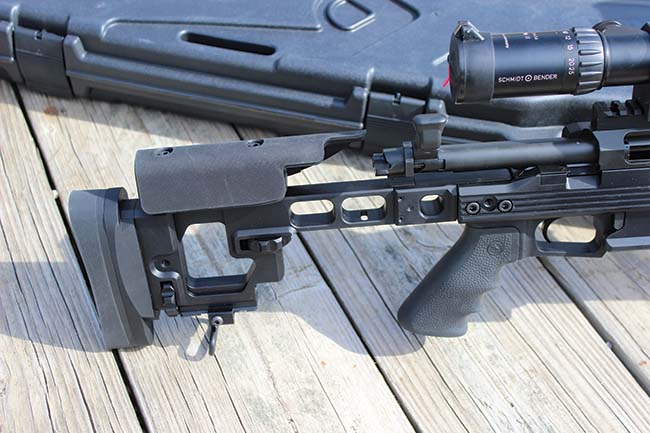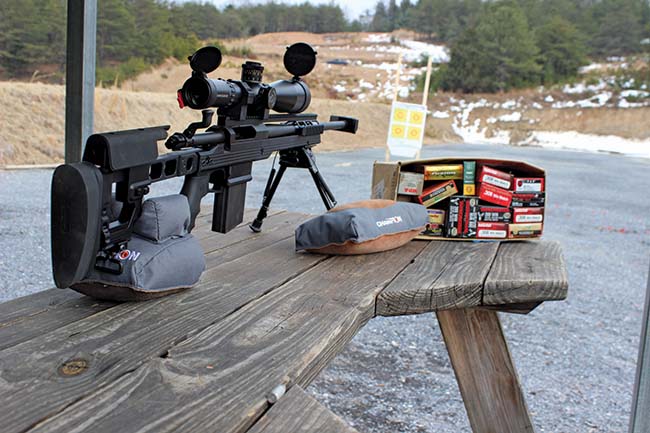ABOVE: The ArmaLite AR-31 is meant for prone supported shooting. Its high degree of accuracy rewards the shooter so situated. The AR-31’s aesthetics instills a certain sense of professionalism and purpose. The purpose is long-range accuracy.
It is nice to see a product evolve over time. The ArmaLite AR-31 .308 Win rifle is a great case in point. The AR-31 shares its design lineage with previous ArmaLite precision rifles in the form of the AR-30 and its updated version AR-30A1. The AR-30A1 rifle is chambered in “long action” bolt cartridges such as .300 WinMag and .338 Lapua. The AR-31 takes the no nonsense ArmaLite concept of the tactical rifle another step forward. While the AR-31 (and AR-30A1) may resemble its AR-30 predecessor, only the pistol grip, buttpad, trigger, and a few small components from the original AR-30 transferred over to the AR-31. All other components are new or redesigned. This is especially true with the AR-31’s bolt action. The AR-31’s “short action” describes the length the bolt needs to travel to function/cycle the .308Win cartridge. The longer .300 WinMag and .338 Lapua cartridges require a “long action.” The AR-31’s shorter action provides for a stiffer receiver often translating into better accuracy.
The AR-31 aluminum stock is better described as a “chassis.” The aluminum stock reinforces the receiver like a sleeved bench rest rifle. ArmaLite equips the AR-31 with a competition grade barrel and patented V-block receiver bedding system. These two components are key components to the AR-31’s sub-minute of angle accuracy expectations. There is no bedding in a traditional sense involved with the AR-31; instead a mechanical metal to metal fit is utilized literally wedging the receiver to the stock. ArmaLite’s V-bloc mates the stock to the receiver assuring stability and repeatable accuracy. The ArmaLite aluminum chassis, while not as svelte as a classic wood stock or even fiberglass stock, is very functional for a rifle destined for tactical use. All of the AR-31’s features are calculated to enhance the user’s ability to surgically place .308 Win rounds on target at distance.

Other than its .308Win chambering, one major difference between the AR-31 and AR-30A1 series is being configured with a magazine well to accommodate AR-10B detachable magazines. The AR-10B magazines come in 5-, 10-, 15-, 20- and 25-round capacities. The AR-31 is not a compact rifle. It features a 24-inch, 1:10 twist barrel contributing to an overall length of nearly 46 inches. The rifle weighs 13 pounds empty. The trigger is a single stage affair measuring 4 pounds of pull weight. The stock is fixed with a 13.5 inch length of pull. ArmaLite literature states 1/4-3/4 MOA accuracy is to be expected with the AR-31. The AR-31 is finished with military grade anodizing and phosphating coating to enhance durability and corrosion resistance. The rail atop the receiver for mounting scopes includes 20 minute angled allowing for extended range zeroing.
A unique aesthetic with the AR-31 is the proven ArmaLite muzzle brake screwed on via 5/8 x 24 thread pitch. The threaded muzzle brake on the AR-31 is a standalone feature in its own right. The ArmaLite muzzle brake design was proofed on their AR-50 .50 BMG and is just as effective on the AR-31 allowing for a full range day of firing with no ill effect on shooter in terms of recoil. With that said, if needed, the factory threaded muzzle brake is quickly removed and allows for the AR-31 to be easily adapted for use with a suppressor.

For this evaluation a Schmidt & Bender 5-25x56mm PM II with H2 CMR reticle was mounted on the AR-31 via AWP rings. In the past few years, Schmidt & Bender (S&B) has made a couple of powerful statements by winning two of the most prestigious U.S. military optic contracts. Most recently, S&B was chosen to provide the optic for the U.S. Precision Sniper Rifle (PSR). Schmidt & Bender will be supplying its 5-25×56 PMII scope in a special PSR version to U.S. Army, Navy, Air Force and Marine Special Forces for existing and future sniper rifles. The Schmidt & Bender optic is expected to serve and perform all over the world under widely varying and harsh environmental conditions; whether under water, near coastlines, in arctic surroundings, in the jungle or desert and last, but not least, in urban warfare. Another milestone that established Schmidt & Bender as a major player in the tactical optic market was the S&B 3-12×50 PM II model being chosen for use by the U.S. Marines on their sniper rifles. This was after two years of comprehensive testing by the U.S. Marines against 25 rival scopes.
An American Technologies Network Corporation (ATN) PS22 NVD was used when testing the AR-31 in a night time role. The PS22 is designed to mount in front of a day optic scope. That sounds pretty simple and self-explanatory. However, this feature blows away previous attempts to adapt a day optic scope for use at night. The entire concept is based on wanting to give the user the convenience of using their day optic at night without having to switch out aiming devices or having to dedicate a weapon solely for use at night. Any weapon can be adapted for night use as long as the ATN PS22 can be placed in front of a suitable day optic device. The available choices for the day optic that are compatible to use with the PS22 is wide ranging. One important advantage of the PS22 concept is not requiring the optic to be sighted in every time it is employed, since the day optic never moves. The PS2 is attached or detached with no impact on the day optic’s point of aim and parallax is not an issue. Another benefit of the PS22 is that a scope’s reticle does not need to be illuminated or IR compatible for it to be visible when using the PS22. The extended ArmaLite rail system is ideal for mounting the ATN PS22. The visual quality of the PS22 must be experienced to be fully appreciated with precise fire possible out to 200 yards or further depending on ambient light night conditions. The ATN PS22 serves as force multiplier when employed on the ArmaLite AR-31 allowing for 24 hour use.

The ArmaLite AR-31 was tested over an extended time period constantly producing sub-MOA groups with several different ammunition brands – an important logistic consideration. Various .308Win loadings from Black Hills Ammunition, Federal, Winchester, and Hornady provided the basis for the accuracy tests. The Black Hills Match loads tested consisted of 168 grain and 175 grain Match bullets. The Federal chambering was the venerable 168 grain Match load. 168 grain TAP from Hornady along with Winchester 168 grain Match was also used. The AR-31’s 24-inch barrel produced velocity as promised with the 168 grain and 175 grain loads clocking in at the low to mid 2,600 fps range. As to be expected with quality ammunition, velocity figures within the different loads deviated very little from round to round. This is critical for predicable long range accuracy.
The ArmaLite rifle shot all the premium loads tested into 1 MOA or better at 100 yards; mostly better with 5/8” groups not untypical. It was not deemed necessary to cast the net wider, since Black Hills Ammunition, Federal, Winchester, and Hornady are industry leaders, which is what this type of rifle deserves to wring out its full potential. The bench testing was done off a Champion tripod front rest and rear sand bag. The accuracy figures are based on firing three five-round groups and averaging group sizes. While not statistically full proof, the method certainly represents the AR-31’s capabilities. The Federal 168 grain Match and BHA 175 grain Match produced the best 100 yard accuracy average at only slightly above 1/2”. Rifles can exhibit finicky behavior over which loads are preferred. Again, no loads were over 1 MOA. Another sign of an accurate, dependable rifle is how cold bore zeros compare over time and if the point of aim shifts after a few rounds heat up the barrel. The AR-31 showed no shifts in point of aim and cold bore zeros produced fine groups when overlaid together.

Not a lot of time was spent at the 100 yard range. 300 yards and out is the more indicative test of a weapon system like the ArmaLite AR-31. This generates useful ballistic information for the shooter, especially when it comes to elevation and windage data for log books and ballistic calculations. A tactical rifle weapon system is made up of rifle/optics/ammunition/shooter. Groups were fired at 300 yards with the Federal 168 grain Match and BHA 175 grain Match loads performing the best again. Significantly, all of the loads held onto the 1 MOA (approximately 3” at 300 yard) or better criteria. Most shooters cannot take advantage of this kind of performance.
After testing innate accuracy from the bench, field tests were performed at Echo Valley Training Center (EVTC). This consisted of shooting prone off a bipod or pack. A favorite reactive target has always been the clay pigeon. The bolt was worked as quickly as possible with the next target acquired rapidly for engagement. The AR-31’s muzzle device combined with the ergonomic stock and slick bolt with short lift proved potent. Another note of interest was how easy the Schmidt & Bender H2 CMR reticle made hitting targets at 300 yards and beyond; thanks to sharp image clear hold over points if required. The benefit is obvious of holding directly on target versus an estimated hold over. Also, the H2 CMR reticle is a great tool for estimating target range once one is familiar with the method. Other range work consisted of shooting B-27 man-targets out to 500 yards. The AR-31’s accuracy combined with clear powerful Schmidt & Bender optics enabled rote center mass hits. It was even tempting to try head shots at that distance. Another favorite evaluation drill is to shoot at a Mike Gibson Manufacturing (MGM) Precision Rifle Target placed at 300 yard from the prone position. The MGM Precision Rifle Target features movable target doors simulating the small eye/nose and center chest areas that “open” and “shut” when hit. This provides feedback as to how a rifle performs in terms of bolt manipulation and how the stock interacts with the shooter during recoil as compared to firing off the bench at 100 yards. The combination of the world class Schmidt & Bender 5-25x optics and the AR-31 generated great performance. The work-up at EVTC was done in preparation for much longer range work in mind. EVTC has access to various off site locations where up to 1,000 yards is available. This is a rare commodity, especially outside of any military controlled property.
It was decided to further test the ArmaLite AR-31 using a competition format discovered at a local LE shoot attended annually. Competitors are tasked with engaging multiple hanging clay pigeons at 220 yards followed up with firing at more clay pigeons at 285 yards and then 1/4 scale steel targets placed at 350 yards. Shooting is from the prone position supported by bipod in the front and bag under the buttstock. The inherit accuracy of the AR-31 combined with higher than normal capacity for a bolt action made short work of the course of fire. The oversize handle and smooth passage of the bolt in the raceway allows for minimal disturbance when the rifle’s bolt is worked allowing for fast follow-up shots when engaging multiple targets. The AR-31 stoutly ejected empty cases. One note of interest with the AR-31 is that single loading a cartridge is not feasible as it with other bolt action. This is due to the bolt locking back on the magazine’s follower. With capacity offered by the AR-10B magazines and ease of switching out magazines providing for a “reload,” the practice of single loading cartridges is not as crucial with the AR-31 as it would be with a typical five round bolt action rifle.
There are many “tactical” rifles on the market that are labeled as such based solely on a heavy barrel in a synthetic stock. This is not the case with the ArmaLite AR-31 chambered in .308Win. ArmaLite does not curry for cross over sales appeal with the AR-31. The rifle is a tactical weapon with all design inputs stemming solely from tactical considerations and needs.

SITES OF INTEREST
ArmaLite, Inc.
P.O. Box 299
Geneseo, IL. 61254
(800) 336-0184
www.ArmaLite.com
Schmidt & Bender USA, Inc.
Service Center
(703) 953 1253
www.schmidtundbender.de
Echo Valley Training Center
www.echovalleytrainingcenter.com
Winchester Ammunition
427 N. Shamrock St
East Alton, IL 62024
www.winchester.com
Black Hills Ammunition
PO Box 3090
Rapid City, SD 57709
(605) 348-5150
www.black-hills.com
ATK/Federal Cartridge Company
900 Ehlen Drive
Anoka, MN 55303
(8000 322-2342
www.federalpremium.com
Hornady Mfg. Inc.
3625 Old Potash Hwy
Grand Island, NE 68802
(800) 338-3220
www.hornady.com








